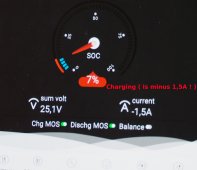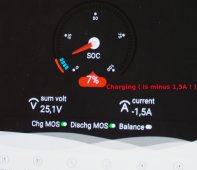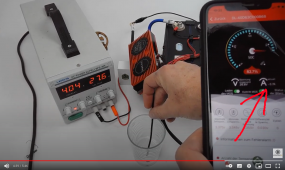Marten
New Member
A random battery cell of 8 pieces stops charging and discharging when it hits the highest or lowest point. (Daly BMS doesn't balance right)
Daly BMS 24V 8S 100A (R16A-GA14) Software version/Firmware: 20201205-1.01G
(sorry for my poor English)
Charging:
Once one cell hits 3.65V, then the Daly BMS stops charging. Balancing is also stopped. The other 7 cells have: 3,451 . 3,454 . 3,398 . 3,389 . 3,399 . 3,395, 3,401
7 battery cells have low voltage :-(
Discharge:
Once one cell hits 2.5V then Daly BMS stops discharging. The other 7 cells have: 2.864 . 2,902. 2,901, . 2.872. 2.861 . 2.845. 2.862.
No balancing while discharging. This is not a defect in one battery cell, it is always a random cell that hits the upper or lower boundary before the others
Any ideas?
Batteries are new from brand manufacturer. (8 x 110Ah LiFePo)
Daly BMS 24V 8S 100A (R16A-GA14) with BT/UART + CAN/485. Software version/Firmware: 20201205-1.01G . BTW: Where can I get new firmware?
--------------------------------
Problem number two:
When charging, the Smart BMS application on the first page shows " minus " ( for example " -4A " ) Once discharged, it does not show a minus. ( for example " 4A " ) This should be reversed, minus must always be displayed when discharging. But it's not. What's the problem?
Thanks
Daly BMS 24V 8S 100A (R16A-GA14) Software version/Firmware: 20201205-1.01G
(sorry for my poor English)
Charging:
Once one cell hits 3.65V, then the Daly BMS stops charging. Balancing is also stopped. The other 7 cells have: 3,451 . 3,454 . 3,398 . 3,389 . 3,399 . 3,395, 3,401
7 battery cells have low voltage :-(
Discharge:
Once one cell hits 2.5V then Daly BMS stops discharging. The other 7 cells have: 2.864 . 2,902. 2,901, . 2.872. 2.861 . 2.845. 2.862.
No balancing while discharging. This is not a defect in one battery cell, it is always a random cell that hits the upper or lower boundary before the others
Any ideas?
Batteries are new from brand manufacturer. (8 x 110Ah LiFePo)
Daly BMS 24V 8S 100A (R16A-GA14) with BT/UART + CAN/485. Software version/Firmware: 20201205-1.01G . BTW: Where can I get new firmware?
--------------------------------
Problem number two:
When charging, the Smart BMS application on the first page shows " minus " ( for example " -4A " ) Once discharged, it does not show a minus. ( for example " 4A " ) This should be reversed, minus must always be displayed when discharging. But it's not. What's the problem?
Thanks





